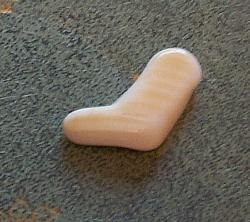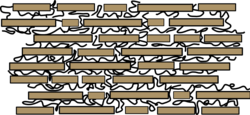Difference between revisions of "AY Honors/Shells - Advanced/Answer Key"
("clay platelets" in picture caption changed to "aragonite platelets") |
|||
| (5 intermediate revisions by the same user not shown) | |||
| Line 1: | Line 1: | ||
[[image:nacre.jpg|thumb|200px|A piece of nacre]] | [[image:nacre.jpg|thumb|200px|A piece of nacre]] | ||
| − | [[image:Nacre_microscopic_structure.png|thumb|200px|A schematic of the microscopic structure of nacre, showing how the layers of | + | [[image:Nacre_microscopic_structure.png|thumb|200px|A schematic of the microscopic structure of nacre, showing how the layers of aragonite platelets are separated by protein.]] |
| − | '''Nacre''', also known as '''mother of pearl''' or '''sadaf''', is a naturally occuring organic-inorganic composite. It is formed of layers of [[calcium carbonate]] (CaCO<sub>3</sub>) platelets ([[crystals]]), in the form of [[aragonite]] and [[conchiolin]] (a [[scleroprotein]]), separated by [[elastic]] [[biopolymers]] (such as [[chitin]] and [[lustrin]]). This mixture of hard and elastic domains makes the material strong | + | '''Nacre''', also known as '''mother of pearl''' or '''sadaf''', is a naturally occuring organic-inorganic composite. It is formed of layers of [[calcium carbonate]] (CaCO<sub>3</sub>) platelets ([[crystals]]), in the form of [[aragonite]] and [[conchiolin]] (a [[scleroprotein]]), separated by [[elastic]] [[biopolymers]] (such as [[chitin]] and [[lustrin]]). This mixture of hard and elastic domains makes the material strong and resilient. |
| − | Nacre is secreted by the [[ | + | Nacre is secreted by the [[epithelial]] [[cell (biology)|cells]] of the [[Mantle (mollusc)|mantle tissue]] of certain species of [[mollusk]]. In these mollusks, nacre is continually deposited onto the inner surface of the animal's shell (the [[iridescent]] ''nacreous layer'', commonly known as ''mother of pearl''), both as a means to smooth the shell itself and as a defense against [[parasite|parasitic organisms]] and damaging detritus. |
The iridescent inner layer is considered highly attractive by many cultures and is often used in making [[jewelery]] or as inlays in wood [[furniture]] and [[guitar]]s. | The iridescent inner layer is considered highly attractive by many cultures and is often used in making [[jewelery]] or as inlays in wood [[furniture]] and [[guitar]]s. | ||
| Line 40: | Line 40: | ||
[[de:Perlmutt]] | [[de:Perlmutt]] | ||
[[fr:Nacre]] | [[fr:Nacre]] | ||
| − | [[pl:Masa | + | [[pl:Masa perłowa]] |
| + | [[sv:Pärlemor]] | ||
Revision as of 21:48, 5 January 2006
Nacre, also known as mother of pearl or sadaf, is a naturally occuring organic-inorganic composite. It is formed of layers of calcium carbonate (CaCO3) platelets (crystals), in the form of aragonite and conchiolin (a scleroprotein), separated by elastic biopolymers (such as chitin and lustrin). This mixture of hard and elastic domains makes the material strong and resilient.
Nacre is secreted by the epithelial cells of the mantle tissue of certain species of mollusk. In these mollusks, nacre is continually deposited onto the inner surface of the animal's shell (the iridescent nacreous layer, commonly known as mother of pearl), both as a means to smooth the shell itself and as a defense against parasitic organisms and damaging detritus.
The iridescent inner layer is considered highly attractive by many cultures and is often used in making jewelery or as inlays in wood furniture and guitars.
When a mollusk is invaded by a parasite or is irritated by a foreign object that the animal cannot eject, a process known as encystation entombs the offending entity in successive, concentric layers of nacre. This process eventually forms what we call pearls and continues for as long as the mollusk lives.
Chief sources are the pearl oyster, found in warm and tropical seas, primarily in Asia; freshwater pearl mussels, which live in many rivers of the United States, Europe, and Asia; and the abalone of California, Japan, and other Pacific regions.
Decorative uses
Tiles: Small, hand-cut shapes with straight edges, called 'tesserae', are laminated to either a marble or a ceramic base. The tesserae are hand placed and closely sandwiched together, creating an irregular mosaic or pattern (such as a weave). The laminated material is typically 1/16 of an inch thick.
Sheets: Instead of using a marble or tile base, the mother of pearl tesserae are glued to a fiberglass mesh. The result is a lightweight material that offers a seamless installation, and there is no limit to the sheet size. Mother of pearl sheets may be used on interior floors, exterior and interior walls, countertops, doors and ceilings. Insertion into architectural elements, such as columns or furniture is easily accomplished.
Both black and white mother of pearl are used for architectural purposes. The natural mother of pearl may be artificially tinted to almost any color.
Mother of pearl is also used to clad porcelain sinks. Mother of pearl tesserae may be cut into artistic shapes and be laminated to ceramic tile and surrounded by numerous coats of colored lacquer to create an artistic design. The lacquer and the mother of pearl are polished at the same time, creating a durable, glossy hard surface.
It is also available in thin laminated sheet form, allowing easy inlay and cladding work, and modern ceramic tiles.
Reference
- Lin, A., and Meyers, M.A. 2005. Growth and structure in abalone shell, Materials Science and Engineering A 390(Jan. 15):27–41 ([1])
- Mayer, George, "Rigid Biological Systems as Models for Synthetic Composites", Science 310 (18 Nov 2005):1144–1147
([2])


